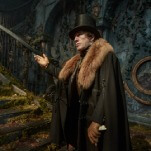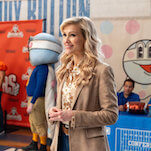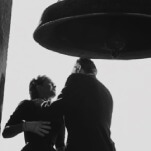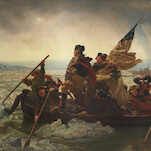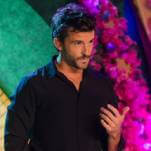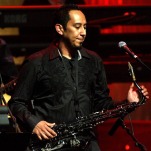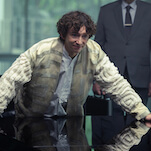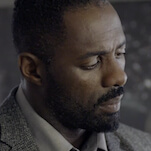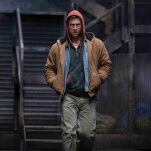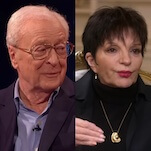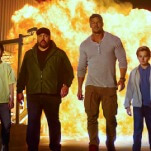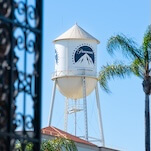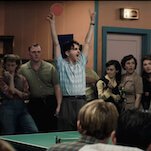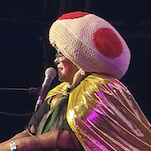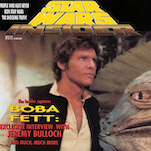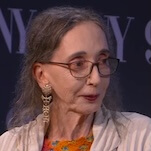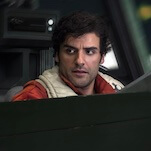A minute and a half into Other Space, Paul Feig’s new sci-fi comedy for Yahoo! Screen about an untested spaceship crew getting lost in another universe, we see a revealing sight: a man in a skirt next to a woman in pants. They’re high-ranking officers in whatever paramilitary scientific enterprise is giving out spaceships to college grads in the world of Other Space, and these are their uniforms. If you’re not watching closely you could miss the skirt entirely. Feig doesn’t call attention to it with the script or the camera, although the next scene is a discussion mocking the ancient gendered custom of wearing neckties as opposed to gender-neutral “collar balls,” the truck nuts of future formal wear. But sure enough, in a few minutes another man shows up in a skirt, this one lankier, looking from the waist down something like Dana Carvey’s Church Lady. By keeping such a straight face, Feig’s creating sight gags for his 21st century audience while demonstrating how gender roles have changed by the 22nd. He’s sneaking the sci-fi speculation in with the comedy. That’s how Other Space flies past the real final frontier into a future where bisexuality is the norm.
Bisexuality in 2015 terms, that is. A recent YouGov poll reveals 29 percent of Americans under 30 classify themselves as neither strictly heterosexual nor strictly homosexual, but rather somewhere in between, and nearly half of young Britons too. Monosexuality may well be as outdated as neck ties to the characters of Other Space. They might not call themselves bi, but pretty much all are attracted to both men and women over the course of the season. That’s a giant leap for genre TV.
Speculative TV has never been very speculative about sexuality. The great subject of Lost is how love can transcend the laws of physics (or is it metaphysics?), but apparently only for opposite-sex couples. That’s emblematic of the whole genre. To be an LGBTQ fan of sci-fi TV is to suffer the recurring rigmarole: Of course producers would love to feature LGBTQ characters if only they could figure out how to do that without making it a whole thing.
So fans went there on their own. Slash fiction reportedly originated with Captain Kirk/Mr. Spock stories. In response, Star Trek creator Gene Roddenberry addressed the bond between the men in his novelization of The Motion Picture, with Kirk admitting his “best” sexual experiences have been with women. And his worst? The implication was clear. With that, Roddenberry inaugurated a 35-year struggle between fans and producers for queer representation in sci-fi TV.
A month before casting began on Star Trek: The Next Generation, Roddenberry admitted, “We should probably have a gay character on Star Trek.” That didn’t happen. But at least there was a gay writer in the room, David Gerrold, who wrote a first-season script telling an AIDS allegory via a guest actor concerned about his sick boyfriend. It was scrapped. At the start of the fifth season, Roddenberry promised the series would finally get into queer stories, and there would be gay crewmen on the Enterprise. He died before realizing his vision, and 20 seasons of Star Trek later, we’re still waiting for someone to catch his baton. Time and again, space shows fail to represent the future their own producers believe in. According to TV, the future is feminist, racially diverse, and straight as an arrow.
Why are there no gay characters in Star Trek? After Trek writer Ronald D. Moore left the franchise, he put it bluntly: “There is no answer for it other than people in charge don’t want gay characters in Star Trek.” Then he went through the same old song and dance as executive producer of Battlestar Galactica. “I think homosexuality definitely exists in the world of Galactica, but I frankly haven’t found a way to portray it yet. It’s a texture that I’d like to introduce into the series without doing ‘the gay episode,’” he wrote on his blog. Eventually Moore did find a way to introduce homosexuality into his story without doing the gay episode. He revealed there was a same-sex relationship between two dead women in a prequel TV movie, and later he outed a second-tier character in a webisode. The character was killed off four episodes into the new season, but that’s business as usual on Battlestar Galactica.
In the early ’90s Star Trek tried a few “gay episodes,” using sci-fi twists like the Trill species, symbiotic aliens who outlive their humanoid host bodies and wind up living in hosts of multiple genders over their lifetime. So a Trill in a woman’s body who fell in love with a man would still be in love with him after transitioning into a man’s body. Star Trek’s brief tradition of queerness begins with a female character on The Next Generation deciding she’s not fluid enough to stick with her Trill boyfriend now that he’s in a female body and ends with a female character on Deep Space Nine throwing caution to the wind and reuniting with a Trill ex who now inhabits a female body. The latter even delivered Star Trek’s first (and so far, only) same-sex kiss.
The real landmark is Lexx, a Canadian-German space opera that’s kind of like a tour through the different rooms at an intergalactic sex party. Our guides are a manly man, a horny woman, a dead goth, and a robot head with a man’s voice. At one point they visit a colony of monks who only have sex (with one another and with great relish) on the summer solstice and reproduce thanks to a convenient egg bank. Most of the monks are only situationally gay, and after a lengthy dry spell, the staunchly straight captain of the Lexx finds himself giving in to the situation, too. In another episode, the dead goth liberates some gay men in drag from hell, but as they make their way to heaven, they’re sabotaged by the robot head, who has a crush on the goth and is jealous of the attention he gave the damned gays. While the other space operas were staying in for the evening, Lexx was cutting loose.
The idea on space TV is that sexual fluidity is so normalized that nobody would bat an eye at two women on a date (well, nobody except Mal Reynolds and the crew on Firefly). The problem is none of these shows actually depict such societies. Babylon 5 got half a scene out of the concept, when two of its male characters have to go undercover. Their story: “A young married couple on holiday to Mars for their honeymoon.” Eight months earlier Bill Clinton had signed the Defense Of Marriage Act, the law that federally defined marriage as an act between one man and one woman. It was only a scene, but Babylon 5 saw a future for same-sex marriage. These are the scraps we cling to.
Other series didn’t even make it that far. Stargate: Atlantis writer Joseph Mallozzi followed in J.K. Rowling’s footsteps by outing some characters after the show was over. Not only is one of the recurring characters secretly gay offscreen, but it turns out a hetero love triangle was supposed to have a fourth, queer leg that got cut for time. Moore had it right: The fact is, LGBTQ characters just aren’t a priority for these writers’ rooms. That’s how we still wind up with shows like Constantine, which took a bisexual comic book antihero and reimagined him straighter and narrower for the small screen.
It took a gay writer with some clout to make some progress. Russell T. Davies, the man behind Queer As Folk and more recently Cucumber and Banana, devised a spin-off of the resurgent Doctor Who franchise around the apparently omnisexual Captain Jack Harkness (John Barrowman). The tantalizing promise was that every main character on Torchwood would have a same-sex dalliance in the first season. It was a great idea. Unfortunately those dalliances tended to be brought on by possession or alien artifacts, while the long-term romantic arcs divide neatly into a hetero love triangle and a gay romance. In other words, most of these characters are Kinsey 1s, which is not to dispute their bisexuality or Torchwood’s progress, but television doesn’t lack for mostly straight characters falling off the wagon for an episode.
Around the time Battlestar ended, sci-fi TV skipped right to the stable partnership phase of queer representation, like a frozen TV that suddenly skips ahead when it clears up. Ronald D. Moore’s pilot Virtuality, an essential forerunner to Other Space that was broadcast as a TV movie, featured a gay couple among the crew of its reality-show ship. Next, Stargate Universe cast Ming-Na Wen as Camile Wray, a lesbian in a 12-year partnership with a woman that stands the test of time, or at least the premise, with Camile stranded billions of light years from home. (They share scenes thanks to the other part of the premise, magical stones that allow Camile to swap bodies with people back on Earth.) A few months later, Battlestar spin-off Caprica debuted with gruff patriarch Bill Adama’s uncle turning out to be a gay, married mob enforcer. The gay episode had given way to the gay supporting character. At a time when gay people were excluded from marriage state by state on Earth, at least they found loving partnerships in space.
Flash-forward to 2015. Other Space is more in the Torchwood mold, although it’s been in the works since even before Captain Jack debuted. But its depiction of sexuality begins with fluid gender roles, like the male officers wearing skirts. Another early joke is when new captain Stewart Lipinski (Karan Soni, who might also play the first person of South Asian descent to captain a starship in U.S. TV history) reveals he stole the role of Juliet from his sister, second-in-command Karen (Bess Rous). When producers imagine gender in the future, they often settle on showing women accessing traditionally masculine roles, like the stereotypical badass warrior woman or the macho co-ed barracks of Battlestar Galactica. What Other Space does that’s so unusual is allow its men to embrace traditionally feminine roles, too. Like the skirt/pants image, the recurring situation on Other Space pits a submissive man against a violent woman. Relatively violent, that is. It’s a crew of Sam Weirs and Kim Kellys.
Opposite-sex relationships make up the main stories, but we’re regularly reminded that the characters aren’t so rigid. It’s just that Other Space obscures the issue with its sci-fi situations and underplays it because it’s no big deal. The second episode does the Torchwood thing, with an alien twist behind the same-sex attractions, so it’s hard to sort the real feelings from the fake for these characters we’ve just met. But gradually the sexual fluidity of the crew becomes more and more explicit to the point where one plot hinges on a surprise revelation of a same-sex romance. And that’s what’s really clever. Feig and showrunner Owen Ellickson aren’t just depicting bisexuality. They’re finding comedic and dramatic tension in turning our heteronormative expectations against us. At one point, Karen razzes Stewart by sarcastically asking about an alien’s intentions. “What’s he doing, Stewart? You should know. He’s your boyfriend.” Stewart sighs. “Shut up. I haven’t had a boyfriend in years.” At first it sounds like she’s emasculating him by calling him gay, but really she’s just mocking his (non-sexual) obsession with this alien. It turns out Stewart has dated men and even feels a little disappointed that it’s been so long. The joke’s on us for not expecting a future where bisexuality is the norm.
Other Space doesn’t look like a landmark, but bisexuality is still rarely represented on-screen, especially male bisexuality. Wired recently took some heat for describing the history of sci-fi as one of gradual expansion to minority writers, which isn’t true. Samuel R. Delany, Ursula K. Le Guin, and many more have written speculative fiction about gender and sexuality for ages, and their small-screen counterparts have even been writing scripts for these shows. But it is true that when it comes to queer characters on-screen, space shows have only gradually and reluctantly opened the door. Other Space hasn’t been renewed yet, but those first eight episodes have already advanced the genre. In terms of sexuality, Other Space brings sci-fi TV up to the present.
